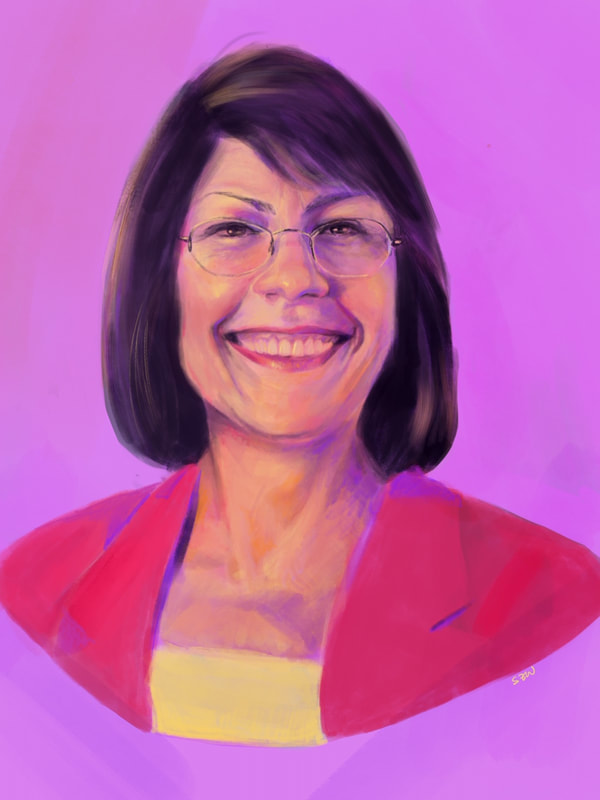By Clara Chalmers
In an inconspicuous corner of Sabrina Wang’s— a (somewhat) freshly minted Collingwood alumni —blog lies her biography, “ I’m a recent neuroscience graduate and you’ve come across my art website. I do portraits and other things.” These succulent sentences describe that rare type of person, hardly encountered, who has unearthed both passion, as well as talent, for two seemingly antitheses disciplines— science and art—yet still manages to retain an air of nonchalance. Her blog posts highlight her humour, amiability, and intelligence, affixed to images that demonstrate an indisputable talent.
Sabrina’s brilliant sketches, however varied in subject matter and mediums, are anchored by a common thread. She documents what she observes — sunsets, portraits of celebrities, Vancouver’s skyline — with impressive lifelikeness, yet she also suffuses her art with a unique filter. Something whimsical, and surreal seems to cling to each carefully rendered piece, emitting the impression that Sabrina has captured, and transformed, the light to create an almost otherworldly reflection.
Color is another distinct feature of this “Sabrina-esque” style, characterized by her favourite times of day: sunset and sunrise. Her blog is the container for these diverse works, as well as a platform to gain commissions by an increasingly growing fan network . Catalogued are mere whims — haphazard doodles, birthday cards for friends — as well as larger scale projects, such as “100 F***ing headings”, a 4-year enterprise illustrating Sabrina’s indomitable perseverance.
In an inconspicuous corner of Sabrina Wang’s— a (somewhat) freshly minted Collingwood alumni —blog lies her biography, “ I’m a recent neuroscience graduate and you’ve come across my art website. I do portraits and other things.” These succulent sentences describe that rare type of person, hardly encountered, who has unearthed both passion, as well as talent, for two seemingly antitheses disciplines— science and art—yet still manages to retain an air of nonchalance. Her blog posts highlight her humour, amiability, and intelligence, affixed to images that demonstrate an indisputable talent.
Sabrina’s brilliant sketches, however varied in subject matter and mediums, are anchored by a common thread. She documents what she observes — sunsets, portraits of celebrities, Vancouver’s skyline — with impressive lifelikeness, yet she also suffuses her art with a unique filter. Something whimsical, and surreal seems to cling to each carefully rendered piece, emitting the impression that Sabrina has captured, and transformed, the light to create an almost otherworldly reflection.
Color is another distinct feature of this “Sabrina-esque” style, characterized by her favourite times of day: sunset and sunrise. Her blog is the container for these diverse works, as well as a platform to gain commissions by an increasingly growing fan network . Catalogued are mere whims — haphazard doodles, birthday cards for friends — as well as larger scale projects, such as “100 F***ing headings”, a 4-year enterprise illustrating Sabrina’s indomitable perseverance.
Yet, despite this blossoming portfolio, Sabrina Wang did not always exalt herself to the status of “artist.” As a science fanatic, adopting the title was a gradual process, though the passion was always there. Her creativity was cultivated, in part, by Collingwood’s art teachers, such as Ms. Geddes, who enabled Sabrina to have “free reign” over her AP portfolio, composed of pieces “dubiously” related to the topic at hand. Vancouver also incised its influence into her pieces, offering a beauty manifesting itself in seasons, architecture, and a plethora of galleries frequented by the art-loving Wang family.
Along with her environment, people also played a hand into Sabrina’s well of inspiration, artists like Cindy Sherman, renowned for her bizarre Instagram posts, and Kehinde Wiley, who, according to Sabrina, successfully merged art with politics without being “pithy or cheesy” garnering her admiration. She is similarly affected by the legacies of classic artists, such as Paul Cezanne, demonstrating an attuned appreciation for old masters.
Following graduation, art morphed from a budding pastime to something almost therapeutic; warding off the all-consuming flame of her studies, and preserving Sabrina’s wavering sanity. She continued to flourish; swapping traditional mediums of charcoal for digital formats, establishing a blog, and, recently, taking on a project entitled “Women of Hopkins,” a tribute to her own alma mater. Change, and the willingness to experiment, are nestled in the nucleus of her craft; she adapts to new experiences (and observations,) refines weak points, such as anatomy, and consistently departs from her style, undaunted by the threat of failure. Moving into medical school, Sabrina will continue tending to and enriching her already burgeoning passion, a flame likely never to be extinguished.






